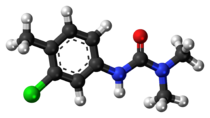Effects of the storage conditions on the stability of natural and synthetic cannabis in biological matrices for forensic toxicology analysis: An update from the literature
Contents

| |

| |
| Names | |
|---|---|
| Preferred IUPAC name
N′-(3-Chloro-4-methylphenyl)-N,N-dimethylurea | |
| Other names
CTU, chlorotoluron, 3-(3-Chloro-4-methylphenyl)-1,1-dimethylurea
| |
| Identifiers | |
3D model (JSmol)
|
|
| ChEBI | |
| ChemSpider | |
| ECHA InfoCard | 100.035.978 |
| EC Number |
|
PubChem CID
|
|
| UNII | |
CompTox Dashboard (EPA)
|
|
| |
| |
| Properties[1] | |
| C10H13ClN2O | |
| Molar mass | 212.67602 |
| Melting point | 148 °C (298 °F; 421 K) |
| log P | 2.41 |
| Hazards[2] | |
| GHS labelling: | |
 
| |
| Warning | |
| H351, H361d, H410 | |
| P201, P202, P273, P281, P308+P313, P391, P405, P501 | |
Except where otherwise noted, data are given for materials in their standard state (at 25 °C [77 °F], 100 kPa).
| |
Chlortoluron, chlorotoluron and CTU are the common names[3] for an organic compound of the phenylurea class of herbicides used to control broadleaf and annual grass weeds in cereal crops.
History
In 1952, chemists at E. I. du Pont de Nemours and Company patented a series of aryl urea derivatives as herbicides. Several compounds covered by this patent were commercialized as herbicides: monuron (4-chlorophenyl), diuron (3,4-dichlorophenyl) and chlortoluron, the 3-chloro-4-methylphenyl example.[4][5] Subsequently, over thirty related urea analogs with the same mechanism of action reached the market worldwide.[6]
Synthesis
As described in the du Pont patent, the starting material is a substituted aryl amine, an aniline, which is treated with phosgene to form its isocyanate derivative. This is subsequently reacted with dimethylamine to give the final product.[4]
- Aryl-NH2 + COCl2 → Aryl-NCO
- Aryl-NCO + NH(CH3)2 → Aryl-NHCON(CH3)2
Mechanism of action
The phenylurea class of herbicides including chlortoluron are inhibitors of photosynthesis. They block the QB plastoquinone binding site of photosystem II, preventing electron flow from QA to QB.[7] This interrupts the photosynthetic electron transport chain and kills the plant.[8]
Chlortoluron is in the Group C, (Australia), C2 (global), Group 7, (numeric), herbicide resistance class.[9]
Usage
Chlortoluron was first licensed for use in the European Union in 1994[9] and this has been extended, currently until October 2021.[10] It is now mainly used in mixture with other herbicides including diflufenican and pendimethalin.[11]
It can be used to control broadleaf weeds and grasses including Alopecurus myosuroides, Anthemis arvensis, Atriplex prostrata, Calendula spp., Convolvulaceae spp., Galeopsis spp., Lamium spp., Papaver rhoeas, Paspalum distichum, Poa annua, Solanaceae spp., Stellaria media and Veronica spp. It is mainly used in cereal crops including wheat and barley.[9][11]
United Kingdom
Chlorotoluron was banned in the UK in 2010, but in 2014 was reapproved after new formulations came with lower application rates, 250 g/Ha down from (up to) 3500 g/Ha, though farmers must spray it earlier in weeds' growth cycles. Agform did this at the same time to the previously banned isoproturon; both reregistrations are mixes with diflufenican, chlorotoluron's Tower® also contains pendimethalin.[12]
References
- ^ EPA Comptox database. "Chlorotoluron". comptox.epa.gov. Retrieved 2021-03-26.
- ^ PubChem database. "Chlorotoluron". pubchem.ncbi.nlm.nih.gov. Retrieved 2021-03-27.
- ^ "Compendium of Pesticide Common Names". alanwood.net.
- ^ a b US patent 2655445, Todd C.W., "3-(Halophenyl)-1-methyl-1-(methyl or ethyl) ureas and herbicidal compositions and methods employing same", issued 1953-10-13, assigned to E. I. du Pont de Nemours & Co.
- ^ Liu, Jing (2010). "Phenylurea Herbicides". Hayes' Handbook of Pesticide Toxicology. pp. 1725–1731. doi:10.1016/B978-0-12-374367-1.00080-X. ISBN 9780123743671.
- ^ "Urea herbicides". alanwood.net. Retrieved 2021-03-26.
- ^ Broser, Matthias; Glöckner, Carina; Gabdulkhakov, Azat; Guskov, Albert; Buchta, Joachim; Kern, Jan; Müh, Frank; Dau, Holger; Saenger, Wolfram; Zouni, Athina (2011). "Structural Basis of Cyanobacterial Photosystem II Inhibition by the Herbicide Terbutryn". Journal of Biological Chemistry. 286 (18): 15964–15972. doi:10.1074/jbc.M110.215970. PMC 3091205. PMID 21367867.
- ^ Oettmeier, Walter (1992). "Herbicides of photosystem II". The Photosystems. pp. 349–408. doi:10.1016/B978-0-444-89440-3.50018-7. ISBN 9780444894403.
- ^ a b c Pesticide Properties Database. "Chlorotoluron". University of Hertfordshire. Retrieved 2021-03-27.
- ^ "Commission implementing regulation (EU) 2020/1511". 2020-10-16. Retrieved 2021-03-27.
- ^ a b Adama (2017). "Tower" (PDF). pcs.agriculture.gov.ie. Archived from the original (PDF) on 2021-11-14. Retrieved 2021-03-27.
- ^ "How agchem firms are breathing new life into old pesticide actives". Farmers Weekly. 15 September 2015.
External Links
- Chlortoluron in the Pesticide Properties DataBase (PPDB)

















